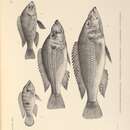Diagnostic Description
provided by Fishbase
Diagnosis: 3 black blotches on sides, the first on opercle, the second at midpoint of body, the third on caudal-fin base; upper profile of snout convex or straight (Ref. 53405).Description: body ovoid; lower jaw scarcely prominent in large individuals; outer and inner jaw teeth monocuspid, inner teeth forming an incomplete row on upper jaw and 2 incomplete rows (only medially) in lower jaw; pharyngeal jaw teeth bicuspid; micro-gillrakers present; scales cycloid (Ref. 53405).Coloration: ground colour olive-brown, with 3 black blotches on either side, first on gill cover, third on caudal-fin base; head with yellow or blue spots forming bands on cheeks and opercular region (sometimes continuing unto sides); opercular spot with green margin; lips and chin reddish; dorsal fin red-edged, with light submarginal band; anal fin light anteriorly, reddish posteriorly; proximal part of caudal fin yellowish, distal part bright red; upper margin of caudal fin red, with light submarginal band; pectorals transparent, hyaline or yellow; pelvics light, their anterior margin red or black (Ref. 53405).
Diseases and Parasites
provided by Fishbase
Ichthyophonus Disease. Fungal diseases
Migration
provided by Fishbase
Potamodromous. Migrating within streams, migratory in rivers, e.g. Saliminus, Moxostoma, Labeo. Migrations should be cyclical and predictable and cover more than 100 km.
- Recorder
- Crispina B. Binohlan
Morphology
provided by Fishbase
Dorsal spines (total): 14 - 15; Dorsal soft rays (total): 10 - 12; Analspines: 3; Analsoft rays: 8 - 9
Trophic Strategy
provided by Fishbase
Feeds on fish scales and insects (Ref. 4577).
Biology
provided by Fishbase
Occurs in mud-bottomed and sand-bottomed canals (Ref. 5723); some distance inland from the coast, associated with areas of intact or recently disturbed forest cover. Considered the true 'jewel fish' of aquarists, this species is also used as an experimental animal by physiologists and ethologists (Ref. 5644). Attains a maximum of 12 cm in captivity. Aquarium keeping: aggressive; in pairs; minimum aquarium size 100 cm (Ref. 51539).
- Recorder
- Crispina B. Binohlan
Importance
provided by Fishbase
fisheries: of no interest
- Recorder
- Crispina B. Binohlan

